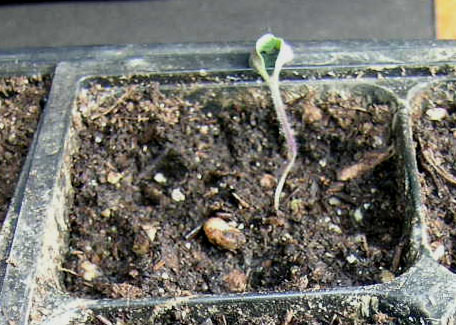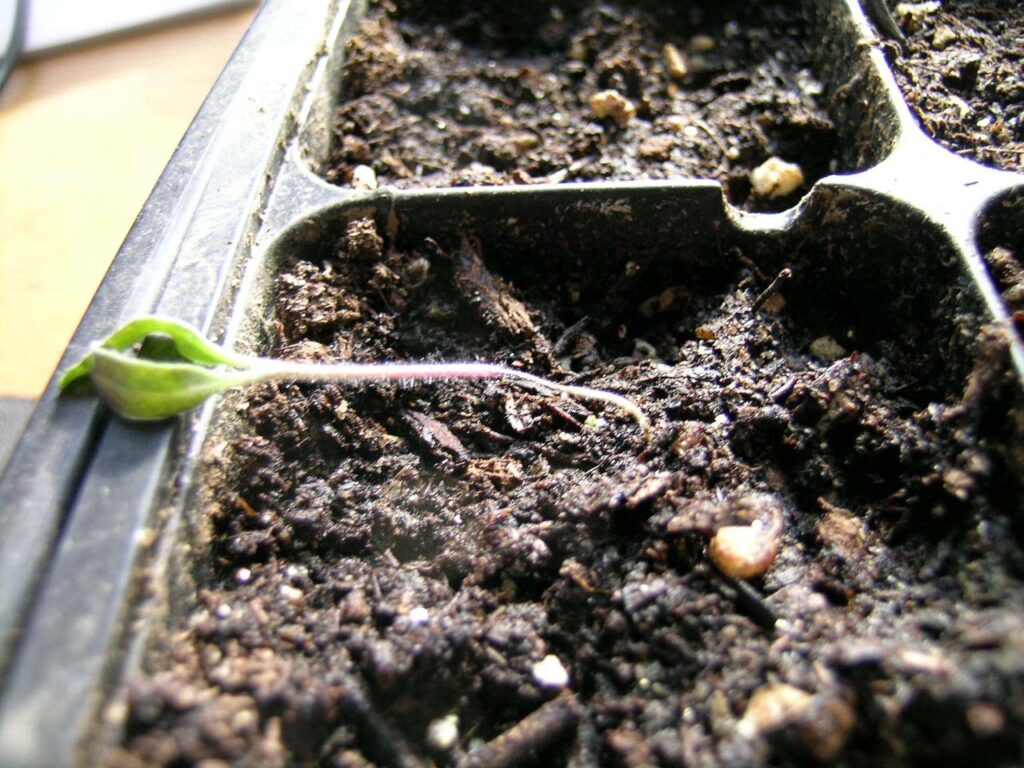
In the early spring, when most plants are still in greenhouses — a much more controlled setting than gardens and fields — a lot of the problems that arise are abiotic (i.e., not infectious). Sometimes abiotic issues are transient (e.g., cold temperatures) so it’s good to both check new growth to see how it looks relative to symptoms elsewhere on the same plant and to check on the health of roots and crown of the plant.
Some ways that seedling problems can occur in compost-based potting mixes are because of the possibility that the compost may be carrying plant pathogens, and because it is much more difficult to predict the availability of nutrients from natural sources. Nutrient availability depends on biological activity — which is greatly affected by temperature, moisture and other factors. Many commercially available organic mixes are quite good — consistently free of pathogens, and good with nutrients — but occasionally even these fail.
Damping-off
Damping-off is a disease most commonly seen in young seedlings but may (rarely) affect older seedlings. It is caused by several species of fungi that commonly live in the upper layers of soil and jump at the opportunity to infect germinating seeds and seedlings, when conditions allow them to. The most common species that cause damping-off are in the genera Pythium and Rhizoctonia.
There are two types of damping-off. The first is pre-emergence damping-off, which rots the sprouting seed before it breaks through the soil. This can be confused for poor seed germination. The fungus attacks any part of the germinating seed, especially the tiny growing tips. Post-emergence damping-off begins as a lesion on the root which extends up to the stem and/or above the soil line. The young stem is constricted by the attack and becomes soft, and the plant falls over and dies.

Management options:
Damping-off cannot be cured, but it can be prevented by starting seeds in better conditions (or a “sterile” media). First make sure you are using seeds of the highest quality that will germinate and start growing quickly. Old, mistreated and weak seeds are more susceptible to damping-off, as anything that slows germination increases the risk of infection. Excessive watering, poor drainage and “less than optimum” temperatures should be avoided. Allowing the surface of the soil mix to dry a bit before each watering helps. Adding perlite to your potting mix can help to facilitate soil drying and aeration.
It is possible to “sterilize” your media by baking the mix in the oven at 350 F for about 45 minutes. The mix should reach 160 F and should stay at that temperature for 30 minutes. Do not allow it to go higher or stay hot longer because overheating kills the beneficial microorganisms and may release toxic materials. Many growers prefer not to “sterilize” their mixes because organic mixes are living systems and often the interactions of organisms in the mix reduces the impact of the fungi causing damping-off. In other words, if the damping-off pathogens get into a “sterile” mix, they are off and running free of antagonists and competitors (friendly or neutral microbes present in many biologically active composts). Adding a biological treatment to your potting mix, like Rootshield, may help to inoculate your seedlings with beneficial microbes that will antagonize or compete with damping-off microbes.

Cold Soil/Wet Soil
In addition to encouraging damping-off, cold soil can cause other problems. For example, growing seedlings on window sills is often a problem because of cold nighttime temperatures. The roots of plants do not function when cold, and plants frequently display symptoms of malnutrition even though the media may have plenty of nutrients. Purple undersides of leaves, stunted growth, pale weak seedlings, etc., are often the results of cold or wet “feet.”
Wet potting mix, or potting mix that doesn’t get a chance to dry out on the surface, can also foster algae growth. While algae are harmless to plants, algae can form crusts on seedling cells that make even watering and drying more difficult, or possibly slow air diffusion in and out of the potting media, which can hinder root growth and further exacerbate wet potting mix problems. Algae may also foster fungus gnats, which feed on algae and fungus in damp potting media, and then sometimes on your tender seedlings’ roots.
Management options:
Trying to grow a tiny seedling in a large container may worsen the problem of wet potting mix because the plant is just not big enough to use the water, and overwatering may then be a problem the plant cannot grow out of. Perlite can help to improve drainage in a poorly-draining potting mix.
The first step in responding to fungus gnats is cultural — reduce the amount of time your potting mix has surface moisture. In severe infestations, there is an OMRI-approved Bt product (Gnatrol, a formulation of the israelensis strain of Bt), and predatory nematodes can be effective in killing larval and pupal stages of the gnats.
Salt
Some composts are high in soluble salts. Even if the salts are nutrient salts such as nitrates, high salts will cause water absorption problems and may prevent seeds from germinating. Salty composts are not a problem in field use because they become diluted with the soil, but in a potting mix it is a real problem. The final blend of a compost-based potting mix (or any other mix) should have salts — measured as electrical conductivity on a compost analysis — below 1, or 4, millimhos per centimeter (mmho/cm), depending on the testing method used.
Carbon:Nitrogen ratio
The C:N ratio is critical for compost used in potting mixes. A high C:N ratio will result in nitrogen lock-up, wherein all the nitrogen in the potting mix, and any you add with fertilizers, is being grabbed by the bacteria feeding on the carbon-rich material. It is a sign that the compost was made from an improper mix of feedstock, or perhaps is just not finished yet. Compost used to make potting mixes should have a C:N ratio of 15:1 to 18:1.
Ammonia
As nitrogen is released from decomposing proteins it passes through a phase where it is an ammonium ion. Unfinished compost will have ammonium ions that may revert to ammonia gas which can kill roots and damage leaves. Ammonia in a compost used for a potting soil should be less than 0.1%. Problems from high ammonia levels can be seen as very weak, dying seedlings which have roots that are brown instead of a nice healthy white. It’s advisable to get an analysis of any compost you plan to use to build your own seedling mix. The University of Maine Soil Testing Laboratory does compost testing, just be sure that when you send a sample you ask for the compost analysis. If you are buying a commercial compost-based mix you may want to speak to other growers and see how that brand has worked for them.
